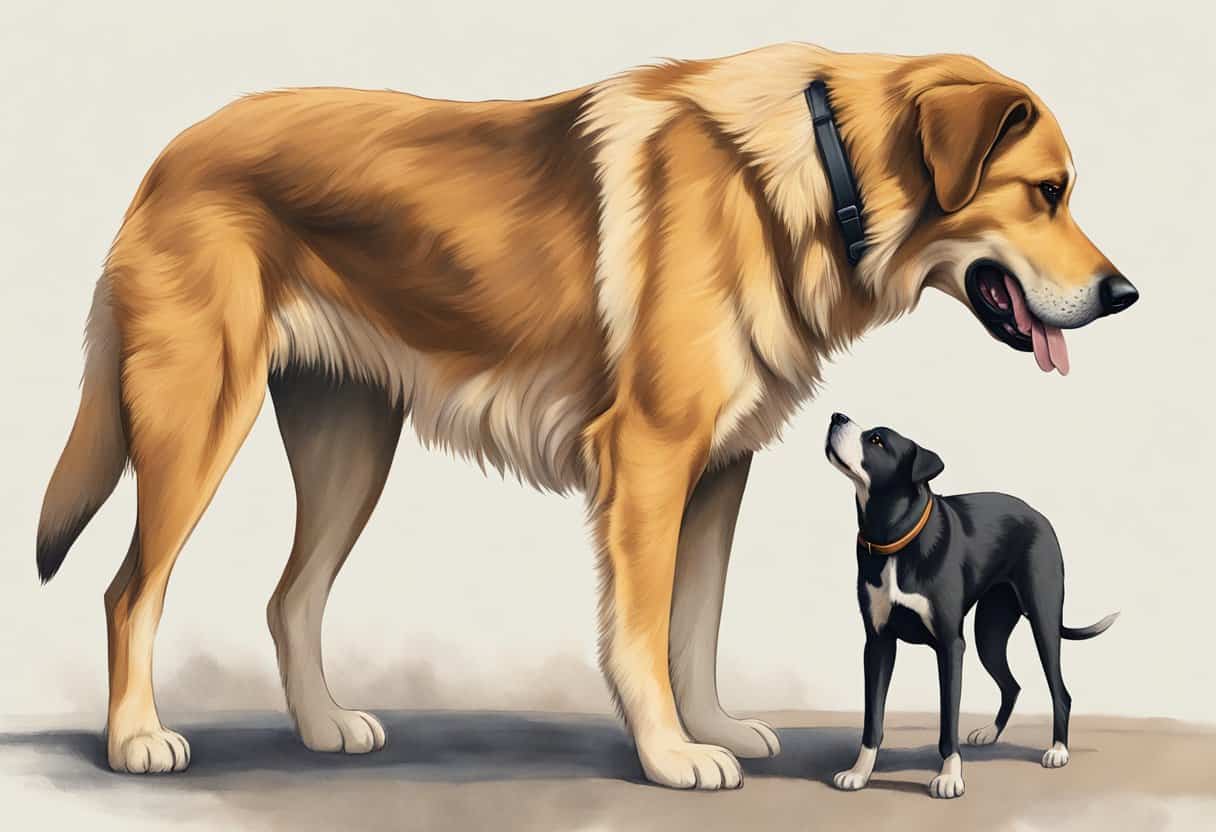This post may contain ads and affiliate links and we may earn a small commission when you click on the links at no additional cost to you. As an Amazon Affiliate, we earn from qualifying purchases. You can read our full disclaimer here.
Dominant Dog Behavior: Understanding and Managing Your Alpha Pet

Ever caught yourself puzzled by your dog’s assertive antics, questioning if they’re showing signs of dominant dog behavior?
Understanding dominant dog behavior is crucial for any dog owner. Dominant behavior in dogs is a way for them to assert control and establish their place in their social hierarchy.
This can manifest in various ways, from resource guarding and body language to interactions with other dogs and people.
Recognizing the signs of dominance can help you address these behaviors effectively, ensuring a balanced and harmonious relationship with your pet.

Recognizing and Managing Dominant Dog Behavior
As an owner, you may notice your dog displaying certain actions such as standing tall, putting their head over another dog’s back, or nudging your hand for attention. These can be indicators of dominant tendencies.
It’s important to differentiate between confident leadership and overbearing dominance, as the latter can lead to behavioral issues, and in some instances, aggression.
Managing dominant dog behavior involves consistent training, clear communication, and establishing boundaries.
It’s not about punishment or asserting your own dominance, but rather creating a structured environment where your dog feels secure and understands expected behaviors.
With the right approach, you can guide your dog to interact appropriately with others and ensure they are a well-adjusted member of your family.
Understanding Dominant Dog Behavior
Understanding dominant behavior in dogs is crucial for effective training and harmonious living. Recognizing the signs and differentiating dominance from aggression will guide your approach to your dog’s behavior.
Defining Dominance in Dogs
Dominance in dogs refers to the control or influence one dog has over others or over resources. It is not a trait but a relationship between animals that is dynamic and situational.
Dominance does not mean aggression; it is about maintaining order and predictability within social structures.
Signs of Dominant Dog Behavior
Dogs show dominance through various behaviors, which can include:
- Body Language: Standing tall, making direct eye contact, and placing heads over another dog’s shoulders.
- Resource Guarding: Controlling access to food, toys, or other desired objects.
- Ignoring Commands: A dominant dog may resist following your instructions, testing boundaries and leadership.
To identify signs of dominant behavior in dogs, observe how they interact with other dogs and humans, especially during meal times or when playing with toys.
Dominance Versus Aggression
It’s important for dog owners to know the difference between a dog trying to be the boss (dominance) and a dog that’s being aggressive.
Being bossy is about a dog trying to be in charge in a peaceful way, while being aggressive means a dog might actually hurt someone or another dog.
Being Bossy (Dominance): This is when your dog is trying to show they’re the leader in a calm way. They’re not trying to hurt anyone; they just want to show they’re in charge. They might stand tall or be the first to walk through a door.
Being Aggressive: This is more serious because it means your dog could cause harm. If they’re growling, trying to bite, or chasing after someone, that’s aggressive behavior.
Here’s a detailed look at bossy versus aggressive behaviors:
| Bossy Behavior (Dominance) | Aggressive Behavior |
|---|---|
| Standing tall and making themselves look bigger | Biting or snapping at people or other animals |
| Placing their head on another dog’s back | Growling, baring teeth, and snarling |
| Nudging your hand or body firmly for attention | Lunging towards or chasing after someone |
| Blocking a pathway or doorway to control movement | Stiffening body posture and fixating stare before an attack |
| Refusing to move off furniture on command | Excessive barking with a threatening tone |
| Keeping toys, food, or beds away from other pets | Ears pinned back and tail tucked while showing teeth |
The Impact of Breed and Sex in Dominance
“The Impact of Breed and Sex on Dog Dominance”
Delving into why dogs show dominant behavior, it’s clear that both breed and sex are influential factors. However, it’s equally important to acknowledge the individual personality and upbringing of each dog.
Breed Influences on Dominant Dog Behavior
Breeds differ in their predispositions towards dominance, influenced by their historical roles and genetic makeup. Here’s a brief overview:
| More Dominant Breeds | Companion Breeds |
|---|---|
| German Shepherds | French Bulldogs |
| Border Collies | Cavalier King Charles Spaniels |
| Rottweilers | Bichon Frise |
| Doberman Pinschers | Pugs |
| Siberian Huskies | Shih Tzu |
Working and herding breeds like German Shepherds and Border Collies may display more dominant traits due to their breeding for leadership roles.
Meanwhile, breeds developed primarily for companionship, such as French Bulldogs, often show less dominance. Yet, training, socialization, and the individual dog’s environment significantly affect behavior across all breeds.
The Role of Sex in Dominance
The sex of a dog also plays a critical role in dominance behavior. Generally, male dogs, particularly those that are intact (not neutered), might exhibit stronger dominance behaviors due to hormonal influences.
They are more prone to marking territory and asserting themselves in social interactions. Females can show dominance too, especially when in heat or competing for resources.
Spaying and neutering can help minimize these behaviors.
Remember, breed and sex offer a starting point for understanding potential dominance in dogs, but the individual’s personality, training, and environment are what truly shape their behavior.
Causes of Dominance in Dogs
Understanding the causes of dominance in dogs is key to addressing and mitigating such behaviors. Specific factors contribute to the emergence of a dominant dog, with socialization and environment playing pivotal roles.
Lack of Socialization
“The Crucial Link Between Socialization and Dominance in Dogs”
Dominance behaviors in dogs often stem from inadequate early social experiences. Dogs that lack proper socialization may use dominance to compensate for their discomfort in social settings or their misunderstanding of social norms.
The Essentials of Early Socialization
Proper socialization during a dog’s formative weeks is critical for preventing dominance behaviors. Key aspects include:
- Varied Interactions: Exposure to a wide array of animals, people, and environments helps a dog learn appropriate social behaviors.
- Critical Period: The window between 3 to 14 weeks is vital for dogs to develop communication skills and comfort around others.
- Preventing Fear: Early positive encounters can help a dog feel secure, reducing the likelihood of dominance as a fear response.
The Impact of Negative Social Experiences
Negative encounters can significantly influence a dog’s behavior, leading to dominance. Important factors to consider:
- Adverse Events: Both single traumatic events and cumulative negative experiences can push a dog towards dominance as a defense mechanism.
- Development of Fear-Based Dominance: Dominance can emerge as a way for dogs to manage their anxiety or fear in social situations.
- Reactivity to Unfamiliarity: Dogs with negative past experiences may react more dominantly in new or uncertain situations to assert control.
Enhancing Social Experiences to Mitigate Dominance
Expanding a dog’s social circle and experiences can be a proactive way to reduce dominance behaviors. Strategies include:
- Diverse Socialization: Regularly introduce your dog to new dogs and people to build their social repertoire and confidence.
- Environmental Exposure: Acclimatize your dog to different settings to improve their adaptability and reduce stress-induced dominance.
- Positive Social Reinforcement: Rewarding positive social interactions encourages good behavior and helps overshadow tendencies toward dominance.
By understanding the connection between socialization and dominance, dog owners can take active steps to foster a more sociable, confident, and well-behaved pet.
Environmental Influences on Dominant Behavior in Dogs
The setting a dog grows up and lives in plays a big role in shaping their behavior, including tendencies towards dominance.
Consider the following factors:
- Consistency in Rules: A clear set of boundaries and consistent rules are crucial. Without them, dogs can become confused about their role within the household, potentially leading them to assert dominance in an attempt to establish clarity and order.
- Access to Resources: Ensuring that your dog has ample and equal access to essential resources like food, toys, and personal attention is important. A scarcity of these resources can prompt a dog to display dominant behavior as they vie for what they need or desire.
- Environmental Stability: A stable and predictable environment helps dogs feel secure. Frequent changes or unpredictable situations can stress a dog, prompting dominant behaviors as a coping mechanism to assert control in an uncertain environment.
Leadership and Authority

In the context of dog behavior, understanding the nuances of leadership and authority can help you guide and influence your dog’s actions effectively.
Solidifying Your Role as Leader in Your Dog’s Life
To effectively establish your position as the leader for your dog, it’s essential to implement and maintain clear and consistent guidelines.
Leadership in the context of dog training revolves around mutual respect and understanding, rather than fear or aggression.
Here’s how to reinforce your leadership effectively:
- Consistent Enforcement: Apply all rules, boundaries, and limitations uniformly at all times. Inconsistencies can confuse your dog and undermine your position as a leader.
- Clear Communication: Utilize straightforward and consistent commands to signal allowed behaviors. Dogs thrive on clear directives as it helps them understand what is expected of them.
- Positive Reinforcement: Reward desired behaviors with treats, praise, or playtime. Positive reinforcement encourages repeat behavior and strengthens your bond.
- Calm and Assertive Energy: Projecting calmness and assertiveness rather than frustration or anger is key. Dogs are highly sensitive to our emotional states and respond better to calm leadership.
- Structured Routines: Establish and maintain routines for feeding, walking, and playtime. Routines provide a framework of predictability that reinforces your role as the pack leader and helps your dog feel secure.
By focusing on these strategies, you’ll not only assert your leadership but also foster a relationship based on respect and trust, leading to a happier and more balanced dog.
Effective Strategies for Exercising Authority With Your Dog
Asserting your authority over your dog involves demonstrating leadership through confident and composed actions. Here are five effective techniques to help you establish and maintain this authority:
- Controlled Walks: Take charge during walks by ensuring your dog walks either beside you or behind you, never in front. This position reinforces your role as the leader in the relationship.
- Consistent Command Reinforcement: Consistently praise and reward your dog for obeying commands. This not only encourages good behavior but also strengthens your bond and reinforces your authority through positive reinforcement.
- Calm Correction: When correcting unwanted behavior, maintain a calm demeanor. Dogs are highly perceptive and respond better to corrections made with a calm and firm tone rather than out of frustration or anger.
- Structured Playtime: Use playtime to assert your leadership by initiating and ending play sessions on your terms. This helps your dog understand that you control the resources and activities, further establishing your authority.
- Routine Establishment: Creating and sticking to a daily routine for feeding, walks, and rest times helps assert your authority by setting clear expectations for your dog. A structured routine signals to your dog that you are in charge of their daily schedule.
Training and Obedience

In addressing dominant dog behavior, a structured approach to training and obedience is crucial for establishing clear communication and proper relationships between you and your dog.
Fundamentals of Obedience Training
Obedience training is about teaching your dog to reliably respond to basic commands such as sit, stay, come, and heel.
Begin with short, focused training sessions using positive reinforcement: reward your dog’s compliance with treats, praise, or play. This approach encourages repetition and willingness.
10 Effective training tips:
- Clear Commands: Utilize distinct, unambiguous cues.
- Immediate Rewards: Provide treats or praise right after your dog follows a command.
- Consistency: Apply the same rules and commands in every situation.
- Patience: Understand that progress takes time; avoid showing frustration.
- Short Sessions: Keep training sessions brief but frequent to maintain attention.
- Positive Reinforcement: Focus on rewarding good behavior rather than punishing the bad.
- Gradual Difficulty: Start with simple commands and gradually increase complexity.
- Body Language Awareness: Use consistent gestures along with verbal commands.
- Distraction Minimization: Begin in a quiet environment, slowly introducing distractions as your dog’s skills improve.
- Regular Practice: Reinforce commands daily to solidify behaviors.
Addressing Dominant Behaviors
When you notice signs of dominant behavior, it’s essential to act firmly yet calmly. Leadership is established through consistent, fair rules and consequences.
| Behavior | Correction Method |
|---|---|
| Refusal to follow commands | Implement time-outs: a brief isolation period. |
| Resource guarding | Practice trade-up: exchange the guarded item with a high-value treat. |
| Pushy behaviors | Set boundaries, deny access to furniture or personal space until calmness is achieved. |
Interventions must be behavioral modifications–not punishments.
Managing and Correcting Dominant Behaviors

When dealing with dominant dog behavior, it’s crucial to address specific issues such as resource guarding, aggressive behaviors, and inappropriate mounting with a consistent and patient approach.
Dealing with Resource Guarding
Resource guarding occurs when your dog aggressively guards their food, toys, or other objects from other dogs or people. To manage this:
- Assessment: Carefully observe when and what your dog is guarding to understand the triggers.
- Training Tips:
- Start by offering treats from a distance to associate your presence with something positive.
- Gradually decrease the distance as your dog becomes more comfortable with your approach.
- If your dog shows signs of aggression, stop and seek professional help to prevent escalation.
Handling Aggressive Behaviors
Aggressive behavior, including dominance aggression, can stem from your dog’s desire to assert dominance or control over situations. Here’s how to approach it:
- Identifying the Cause: Pay attention to when the aggression occurs and what might be triggering it.
- Strategies:
- Redirect Attention: Lead your dog away from triggers and provide an alternative, positive activity.
- Training: Implement consistent obedience training to assert your leadership and command respect without intimidation.
- Note: If aggression is directed towards other dogs, ensure supervised and controlled interactions.
Reducing Inappropriate Mounting
Inappropriate mounting is a behavior some dogs display to exert dominance over people or other dogs. To correct this:
- Understanding: Recognize that this behavior might be reinforced by social interactions or as a response to stress.
- Behavioral Interventions:
- Distraction: Redirect your dog’s focus away from the behavior with commands such as “sit” or “lie down.”
- Socialization: Encourage well-mannered play with other dogs and interrupt any mounting behavior immediately.
- Consistency: Be consistent in your reactions to discourage this behavior without resorting to punishment.
Behavioral and Environmental Enrichment

Behavioral and environmental enrichment is essential to curb dominant dog behavior through consistent stimulation and exercise. Such practices can mitigate behavioral problems.
Importance of Exercise
Exercise is a cornerstone in managing your dog’s dominant behavior. Adequately exercised dogs tend to display fewer behavioral issues such as aggression and hyperactivity.
The table below outlines the recommended daily exercise based on dog size:
| Size of Dog | Minimum Exercise Time |
|---|---|
| Small | 30 minutes |
| Medium | 45 minutes |
| Large | 60 minutes |
Types of exercise include:
- Walking
- Fetch
- Agility training
- Swimming
Providing Mental Stimulation
Mental stimulation is as crucial as physical activity for your dog’s well-being. It redirects their energy and prevents the development of destructive behaviors.
Activities for mental stimulation:
- Puzzle Toys
- Training Sessions
- Hide and Seek with Treats
- Interactive Play
Combining regular exercise with mental challenges creates a balance that can positively affect the environmental factors influencing your dog’s behavior.
Communication Through Body Language

In understanding dogs, recognizing their body language is critical. It informs you about their emotional state and intentions.
Interpreting Dominant Dog Behavior and Body Language
When observing dogs, posture and movement offer cues to their mindset. Dominance may manifest itself through standing tall, with ears and tail held upright.
A dominant dog might stare intently, place a paw on another dog’s back, or inhibit movement, all signaling control.
Meanwhile, aggression can entail bared teeth and growling, while submission appears as a lowered body posture, averting gaze, or exposing the belly.
Understanding these cues enables you to respond appropriately and maintain harmony.
Teaching Commands and Signals
To establish communication with your dog, consistent commands and signals are vital.
Start with basic commands like “sit,” “stay,” or “down” to build a foundation. Your body language must be clear to avoid confusing your dog.
For instance, standing straight with a firm voice tone imparts authority when issuing commands. On the other hand, crouching to their level with a softer voice encourages submission and cooperative behavior.
Commands and Associated Gestures
| Command | Gesture |
|---|---|
| Sit | Hand signal – palm down, moving downward |
| Stay | Hand signal – palm forward, arm extended |
| Down | Hand signal – pointing to the ground with fingers |
Signals are an extension of commands and should be practiced regularly for effective communication.
Your confidence and consistency in using them will help your dog understand and respond favorably, avoiding confusion and potential aggression.
Socialization and Pack Dynamics
In the canine world, proper socialization and understanding pack dynamics are crucial components that influence behavior.
Your dog, as a pack animal, navigates complex social hierarchies that dictate interactions with both humans and other dogs.
Understanding Pack Animals
Pack Structure: You should know that dogs are descendants of wolves, animals that naturally form packs.
A pack is structured around a clear hierarchy, where every member has a specific rank. The most dominant dog is often recognized as the leader or alpha.
This hierarchy influences all interactions within the pack, and your dog instinctively seeks to understand and find their place within it.
Age and Dominance: As dogs mature, their place in the pack’s dominance hierarchy can change, particularly during the transition from puppyhood to adulthood.
During this time, a dog may challenge boundaries more frequently to establish their rank.
Improving Dog’s Socialization
Introduce New Experiences Early: To foster good social behavior, expose your dog to various environments, people, and other animals from a young age.
Start this socialization process during the critical period of 3 to 14 weeks of age to maximize its effectiveness.
- Consistent Socialization: It’s important to maintain consistent social interactions throughout your dog’s life.
Here’s a simple table to guide you on how to socialize your dog at different ages:
| Age Range | Socialization Goals |
|---|---|
| 3-14 weeks | Expose to a wide range of people, animals, and environments |
| 14 weeks-6 months | Continue exposure; reinforce positive interactions |
| 6 months & older | Maintain social experiences; manage dominance signs |
Training and Leadership: Your role is to act as a calm and assertive leader.
Use positive reinforcement techniques to reward good behavior and discourage negative actions. This leadership helps mitigate dominant behavior by setting clear rules and boundaries.
Common Dominant Behaviors and Handling
Recognizing and addressing dominant behaviors in dogs is crucial for establishing a healthy relationship and maintaining an orderly household.
Jumping and Furniture Control
Jumping: Dogs often jump up on their owners or visitors as a way of asserting dominance. To discourage this behavior, consistently turn your back and ignore your dog when it jumps.
Reward your dog only when all four paws are on the ground.
- Preventive Measures:
- Implement a “no jumping” rule from the beginning.
- Use treats to reinforce calm greetings.
Furniture Control: Allowing your dog on furniture can sometimes lead to dominant behaviors such as refusing to move off the couch. Establish clear rules about furniture accessibility.
- Training Tips:
- Train the “off” command using treats as positive reinforcement.
- Provide a comfortable dog bed as an alternative lounging area.
Addressing Excessive Barking
Excessive barking can be a sign of a dog trying to assert control over a situation or demanding attention.
To address this, you must ignore the barking and give attention on your terms only.
- Behavior Correction:
- Do not shout; remain calm and wait for silence.
- Reward your dog only when they are calm and quiet.
Growling: Growling can be a sign of underlying dominance if used to guard resources or space. Train your dog with commands like “leave it” to stop growling over possessions.
Attention-Seeking: Dominant dogs may steal attention from other dogs or demand play incessantly.
It’s important to establish a routine that includes playtime when you initiate it, reinforcing that you are the one who sets the rules for interaction.
When to Seek Professional Help for Dominant Dog Behavior
If your dog exhibits persistent stubborn behavior or other problematic behaviors that resist your training efforts, consider enlisting the aid of a professional dog trainer or behaviorist.
These experts specialize in understanding dog psychology and can provide strategies tailored to your dog’s specific issues.
Signs that you may need professional help include:
- Repeated Disobedience: If commands are consistently ignored, it’s a serious sign of established dominant behavior.
- Aggressive Actions: Growling, snapping, or biting, especially without clear provocation, requires immediate attention.
- Excessive Begging: While seemingly harmless, persistent begging can be a subtle control tactic by dominant dogs.
| Behavior | Action to Take |
|---|---|
| Non-responsive to commands | Seek a trainer for obedience training. |
| Resource guarding | Consult a behaviorist to address possession aggression. |
| Unmanageable on walks | Professional help can teach leash discipline. |
Remember, behavioral problems do not resolve spontaneously, and early intervention can prevent the development of more serious issues. A proficient trainer or behaviorist can also coach you to confidently handle your dog and maintain a leadership role in your pet’s eyes.
- Assessment: A detailed evaluation of your dog’s behavior.
- Customized Training Plan: Tailored strategies to address specific issues.
- Coaching: Guided instructions for you to properly implement these strategies.
Regular follow-ups may be necessary to ensure that the behavior modification techniques are effective. Acting when signs first appear can lead to a better outcome for both you and your dog.
Setting Boundaries and Home Environment for Dominant Dog Behavior
Creating a structured environment in your home is crucial for managing dominant dog behavior. By setting clear boundaries, you help your dog understand their limits and expectations.
This can foster a calm and respectful relationship.
Establish Rules Early:
- Identify which areas of the home are off-limits and consistently enforce these rules.
- If the couch is not for your dog, for example, gently guide them off each time they attempt to climb up.
Consistency Is Key:
- Remain consistent with your commands and rules.
- Variability in enforcement can confuse your dog and exacerbate unwanted behaviors.
Provide Their Own Space
Equipping your dog with a personal area, like a bed or crate, where they can retreat and relax, helps to reinforce the idea of designated zones within the home.
Environmental Control
| Area | Control Measure |
|---|---|
| Living Room | Limit access with baby gates or keep them on a leash. |
| Kitchen | Establish a boundary line they must not cross during meal times. |
| Bedroom | If allowed, define a specific sleeping area for your dog. |
Leash Training:
- Train your dog not to pull on the leash.
- Start indoors in a familiar environment to minimize distractions.
- Use short, frequent sessions with rewards for following commands and maintaining slack in the leash.
Wrapping Up Dominant Dog Behavior
Understanding and addressing dominant dog behavior requires a multifaceted approach that includes recognizing the influence of breed and sex, the critical role of early socialization, the impact of environmental factors, and the importance of establishing clear leadership and exercising authority effectively.
By incorporating these strategies into your training regimen—emphasizing clear communication, consistency, and positive reinforcement—you can foster a respectful and harmonious relationship with your dog.
Remember, effective training and leadership are about building trust and confidence, ensuring your dog is well-adjusted, obedient, and happy.
Through patience, understanding, and consistent effort, you can guide your dog towards becoming a well-behaved and valued member of your family.
-

Coffee Mug – In Dog Coffees I’ve Only Had One
Price range: $11.95 through $14.95 Select options This product has multiple variants. The options may be chosen on the product page
